Games and Art: Exploring Social and Emotional Dimensions
VerifiedAdded on 2022/08/28
|9
|2858
|16
Essay
AI Summary
This essay delves into the multifaceted relationship between games and art, exploring their respective contributions to society and the ways in which they transmit emotional complexity. It begins by defining games as systems of play with quantifiable outcomes and art as a diverse range of human activities expressing imaginative ideas. The essay examines how games facilitate both online and offline social interactions, highlighting the motivational impact of social gaming, and the role of multiplayer online games in fostering interpersonal communication and a sense of belonging. It further discusses the positive psychological and social outcomes of playing games, including the role of competition and self-efficacy in enhancing emotional responses. In contrast, the essay then shifts to art, analyzing its role in eliciting emotional responses, from positive appreciation of beauty to triggering complex emotions like sadness and awe. It examines how art challenges categorical schemes and provides unique experiences, unlike the intellectual pleasure derived from art. The essay concludes by comparing the two, showing how games offer escapism and structured environments, while art appeals to the overarching desires of individuals and provides mental solace and valuable experiences.

Running head: GAMES AND ART
Games and Art
Name of the student
Name of the University
Author note
Games and Art
Name of the student
Name of the University
Author note
Paraphrase This Document
Need a fresh take? Get an instant paraphrase of this document with our AI Paraphraser
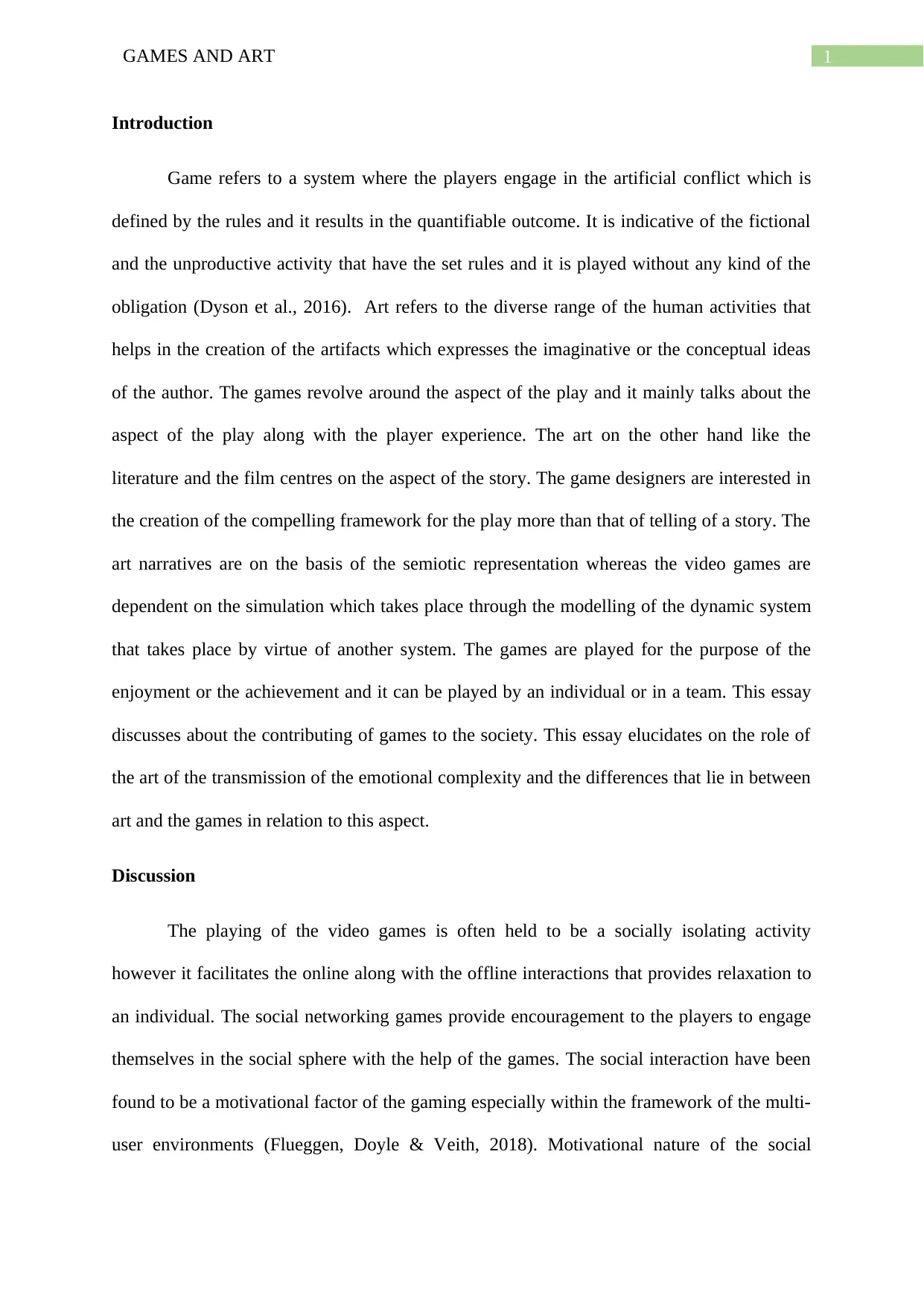
1GAMES AND ART
Introduction
Game refers to a system where the players engage in the artificial conflict which is
defined by the rules and it results in the quantifiable outcome. It is indicative of the fictional
and the unproductive activity that have the set rules and it is played without any kind of the
obligation (Dyson et al., 2016). Art refers to the diverse range of the human activities that
helps in the creation of the artifacts which expresses the imaginative or the conceptual ideas
of the author. The games revolve around the aspect of the play and it mainly talks about the
aspect of the play along with the player experience. The art on the other hand like the
literature and the film centres on the aspect of the story. The game designers are interested in
the creation of the compelling framework for the play more than that of telling of a story. The
art narratives are on the basis of the semiotic representation whereas the video games are
dependent on the simulation which takes place through the modelling of the dynamic system
that takes place by virtue of another system. The games are played for the purpose of the
enjoyment or the achievement and it can be played by an individual or in a team. This essay
discusses about the contributing of games to the society. This essay elucidates on the role of
the art of the transmission of the emotional complexity and the differences that lie in between
art and the games in relation to this aspect.
Discussion
The playing of the video games is often held to be a socially isolating activity
however it facilitates the online along with the offline interactions that provides relaxation to
an individual. The social networking games provide encouragement to the players to engage
themselves in the social sphere with the help of the games. The social interaction have been
found to be a motivational factor of the gaming especially within the framework of the multi-
user environments (Flueggen, Doyle & Veith, 2018). Motivational nature of the social
Introduction
Game refers to a system where the players engage in the artificial conflict which is
defined by the rules and it results in the quantifiable outcome. It is indicative of the fictional
and the unproductive activity that have the set rules and it is played without any kind of the
obligation (Dyson et al., 2016). Art refers to the diverse range of the human activities that
helps in the creation of the artifacts which expresses the imaginative or the conceptual ideas
of the author. The games revolve around the aspect of the play and it mainly talks about the
aspect of the play along with the player experience. The art on the other hand like the
literature and the film centres on the aspect of the story. The game designers are interested in
the creation of the compelling framework for the play more than that of telling of a story. The
art narratives are on the basis of the semiotic representation whereas the video games are
dependent on the simulation which takes place through the modelling of the dynamic system
that takes place by virtue of another system. The games are played for the purpose of the
enjoyment or the achievement and it can be played by an individual or in a team. This essay
discusses about the contributing of games to the society. This essay elucidates on the role of
the art of the transmission of the emotional complexity and the differences that lie in between
art and the games in relation to this aspect.
Discussion
The playing of the video games is often held to be a socially isolating activity
however it facilitates the online along with the offline interactions that provides relaxation to
an individual. The social networking games provide encouragement to the players to engage
themselves in the social sphere with the help of the games. The social interaction have been
found to be a motivational factor of the gaming especially within the framework of the multi-
user environments (Flueggen, Doyle & Veith, 2018). Motivational nature of the social
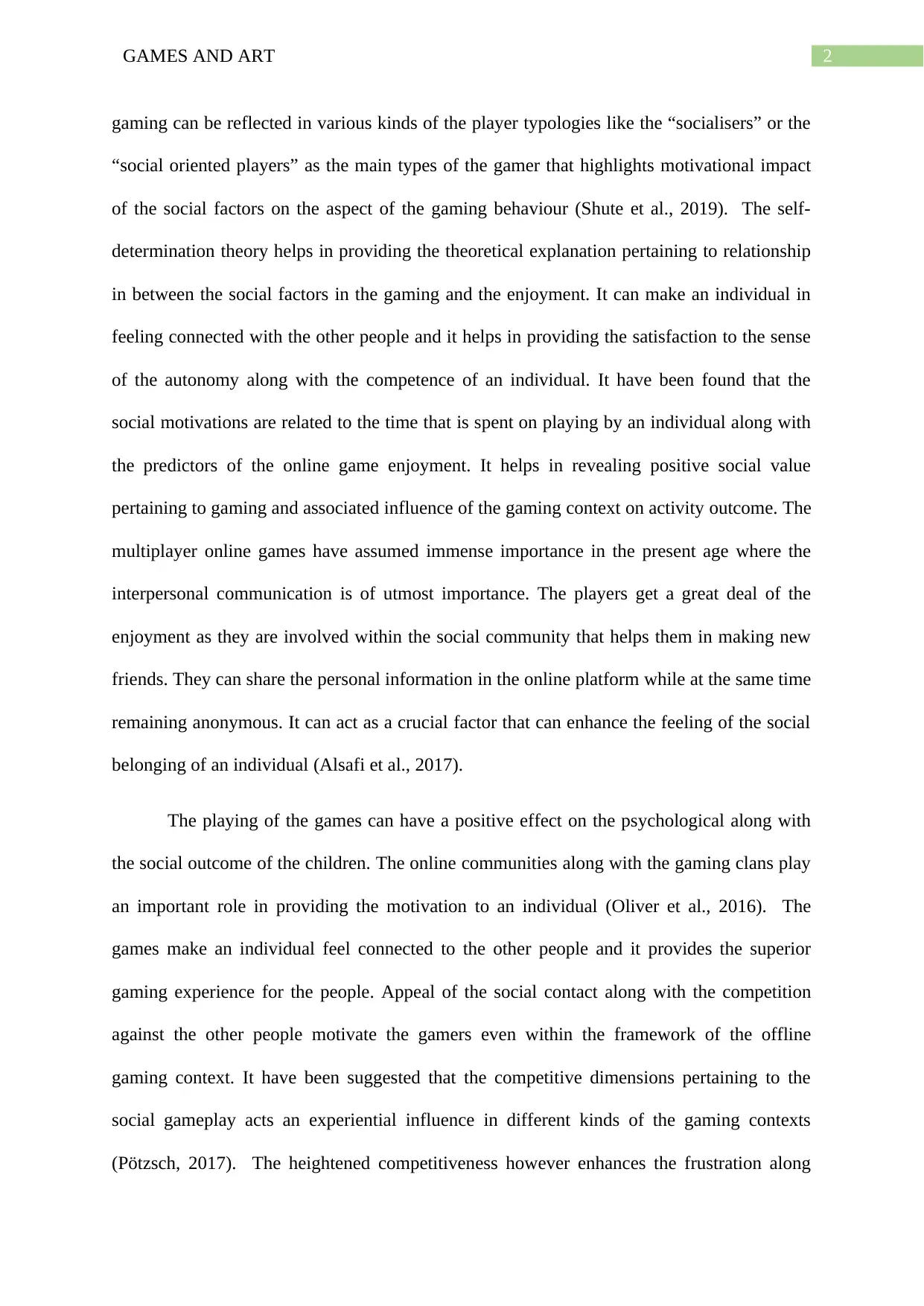
2GAMES AND ART
gaming can be reflected in various kinds of the player typologies like the “socialisers” or the
“social oriented players” as the main types of the gamer that highlights motivational impact
of the social factors on the aspect of the gaming behaviour (Shute et al., 2019). The self-
determination theory helps in providing the theoretical explanation pertaining to relationship
in between the social factors in the gaming and the enjoyment. It can make an individual in
feeling connected with the other people and it helps in providing the satisfaction to the sense
of the autonomy along with the competence of an individual. It have been found that the
social motivations are related to the time that is spent on playing by an individual along with
the predictors of the online game enjoyment. It helps in revealing positive social value
pertaining to gaming and associated influence of the gaming context on activity outcome. The
multiplayer online games have assumed immense importance in the present age where the
interpersonal communication is of utmost importance. The players get a great deal of the
enjoyment as they are involved within the social community that helps them in making new
friends. They can share the personal information in the online platform while at the same time
remaining anonymous. It can act as a crucial factor that can enhance the feeling of the social
belonging of an individual (Alsafi et al., 2017).
The playing of the games can have a positive effect on the psychological along with
the social outcome of the children. The online communities along with the gaming clans play
an important role in providing the motivation to an individual (Oliver et al., 2016). The
games make an individual feel connected to the other people and it provides the superior
gaming experience for the people. Appeal of the social contact along with the competition
against the other people motivate the gamers even within the framework of the offline
gaming context. It have been suggested that the competitive dimensions pertaining to the
social gameplay acts an experiential influence in different kinds of the gaming contexts
(Pötzsch, 2017). The heightened competitiveness however enhances the frustration along
gaming can be reflected in various kinds of the player typologies like the “socialisers” or the
“social oriented players” as the main types of the gamer that highlights motivational impact
of the social factors on the aspect of the gaming behaviour (Shute et al., 2019). The self-
determination theory helps in providing the theoretical explanation pertaining to relationship
in between the social factors in the gaming and the enjoyment. It can make an individual in
feeling connected with the other people and it helps in providing the satisfaction to the sense
of the autonomy along with the competence of an individual. It have been found that the
social motivations are related to the time that is spent on playing by an individual along with
the predictors of the online game enjoyment. It helps in revealing positive social value
pertaining to gaming and associated influence of the gaming context on activity outcome. The
multiplayer online games have assumed immense importance in the present age where the
interpersonal communication is of utmost importance. The players get a great deal of the
enjoyment as they are involved within the social community that helps them in making new
friends. They can share the personal information in the online platform while at the same time
remaining anonymous. It can act as a crucial factor that can enhance the feeling of the social
belonging of an individual (Alsafi et al., 2017).
The playing of the games can have a positive effect on the psychological along with
the social outcome of the children. The online communities along with the gaming clans play
an important role in providing the motivation to an individual (Oliver et al., 2016). The
games make an individual feel connected to the other people and it provides the superior
gaming experience for the people. Appeal of the social contact along with the competition
against the other people motivate the gamers even within the framework of the offline
gaming context. It have been suggested that the competitive dimensions pertaining to the
social gameplay acts an experiential influence in different kinds of the gaming contexts
(Pötzsch, 2017). The heightened competitiveness however enhances the frustration along
⊘ This is a preview!⊘
Do you want full access?
Subscribe today to unlock all pages.

Trusted by 1+ million students worldwide
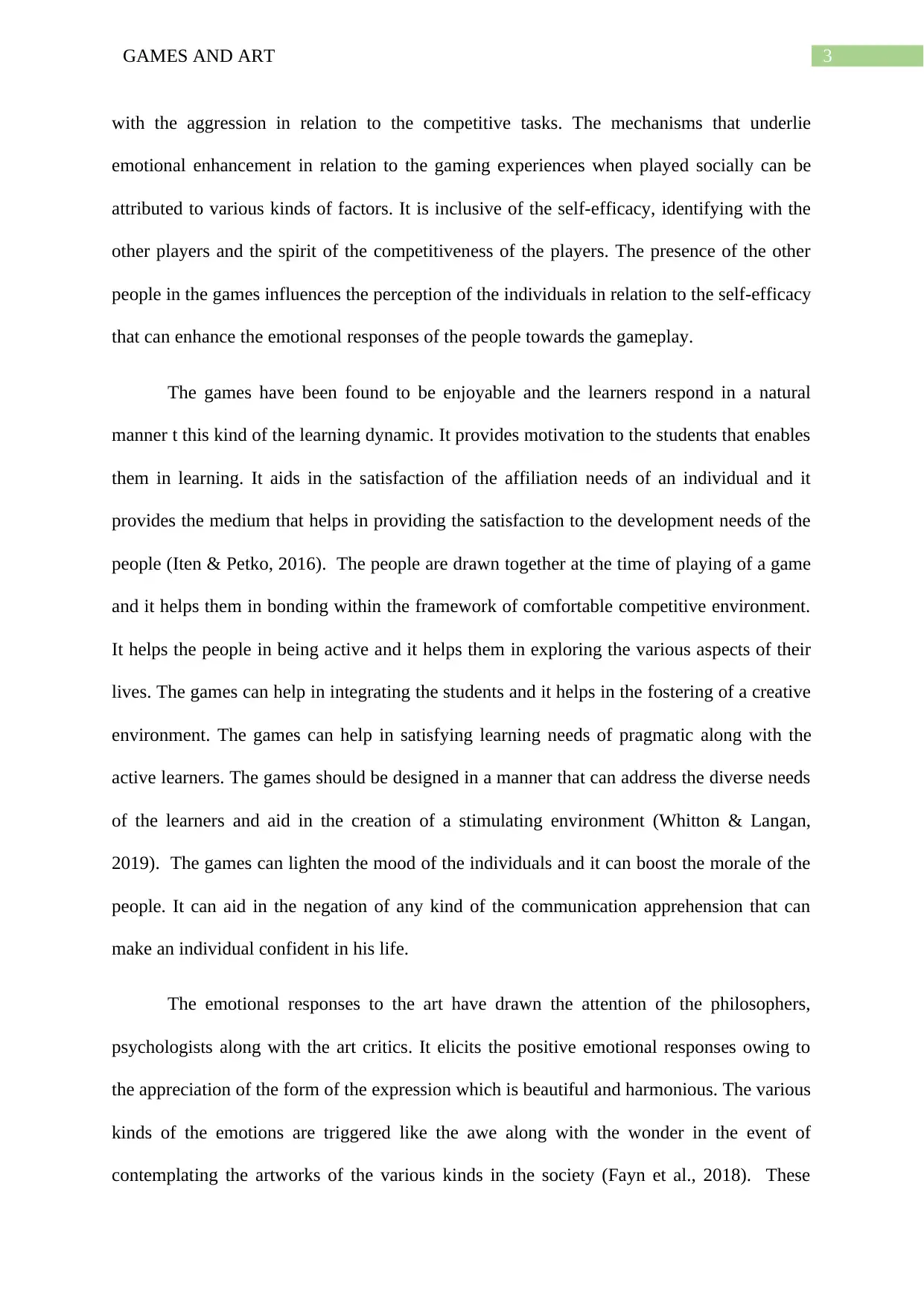
3GAMES AND ART
with the aggression in relation to the competitive tasks. The mechanisms that underlie
emotional enhancement in relation to the gaming experiences when played socially can be
attributed to various kinds of factors. It is inclusive of the self-efficacy, identifying with the
other players and the spirit of the competitiveness of the players. The presence of the other
people in the games influences the perception of the individuals in relation to the self-efficacy
that can enhance the emotional responses of the people towards the gameplay.
The games have been found to be enjoyable and the learners respond in a natural
manner t this kind of the learning dynamic. It provides motivation to the students that enables
them in learning. It aids in the satisfaction of the affiliation needs of an individual and it
provides the medium that helps in providing the satisfaction to the development needs of the
people (Iten & Petko, 2016). The people are drawn together at the time of playing of a game
and it helps them in bonding within the framework of comfortable competitive environment.
It helps the people in being active and it helps them in exploring the various aspects of their
lives. The games can help in integrating the students and it helps in the fostering of a creative
environment. The games can help in satisfying learning needs of pragmatic along with the
active learners. The games should be designed in a manner that can address the diverse needs
of the learners and aid in the creation of a stimulating environment (Whitton & Langan,
2019). The games can lighten the mood of the individuals and it can boost the morale of the
people. It can aid in the negation of any kind of the communication apprehension that can
make an individual confident in his life.
The emotional responses to the art have drawn the attention of the philosophers,
psychologists along with the art critics. It elicits the positive emotional responses owing to
the appreciation of the form of the expression which is beautiful and harmonious. The various
kinds of the emotions are triggered like the awe along with the wonder in the event of
contemplating the artworks of the various kinds in the society (Fayn et al., 2018). These
with the aggression in relation to the competitive tasks. The mechanisms that underlie
emotional enhancement in relation to the gaming experiences when played socially can be
attributed to various kinds of factors. It is inclusive of the self-efficacy, identifying with the
other players and the spirit of the competitiveness of the players. The presence of the other
people in the games influences the perception of the individuals in relation to the self-efficacy
that can enhance the emotional responses of the people towards the gameplay.
The games have been found to be enjoyable and the learners respond in a natural
manner t this kind of the learning dynamic. It provides motivation to the students that enables
them in learning. It aids in the satisfaction of the affiliation needs of an individual and it
provides the medium that helps in providing the satisfaction to the development needs of the
people (Iten & Petko, 2016). The people are drawn together at the time of playing of a game
and it helps them in bonding within the framework of comfortable competitive environment.
It helps the people in being active and it helps them in exploring the various aspects of their
lives. The games can help in integrating the students and it helps in the fostering of a creative
environment. The games can help in satisfying learning needs of pragmatic along with the
active learners. The games should be designed in a manner that can address the diverse needs
of the learners and aid in the creation of a stimulating environment (Whitton & Langan,
2019). The games can lighten the mood of the individuals and it can boost the morale of the
people. It can aid in the negation of any kind of the communication apprehension that can
make an individual confident in his life.
The emotional responses to the art have drawn the attention of the philosophers,
psychologists along with the art critics. It elicits the positive emotional responses owing to
the appreciation of the form of the expression which is beautiful and harmonious. The various
kinds of the emotions are triggered like the awe along with the wonder in the event of
contemplating the artworks of the various kinds in the society (Fayn et al., 2018). These
Paraphrase This Document
Need a fresh take? Get an instant paraphrase of this document with our AI Paraphraser
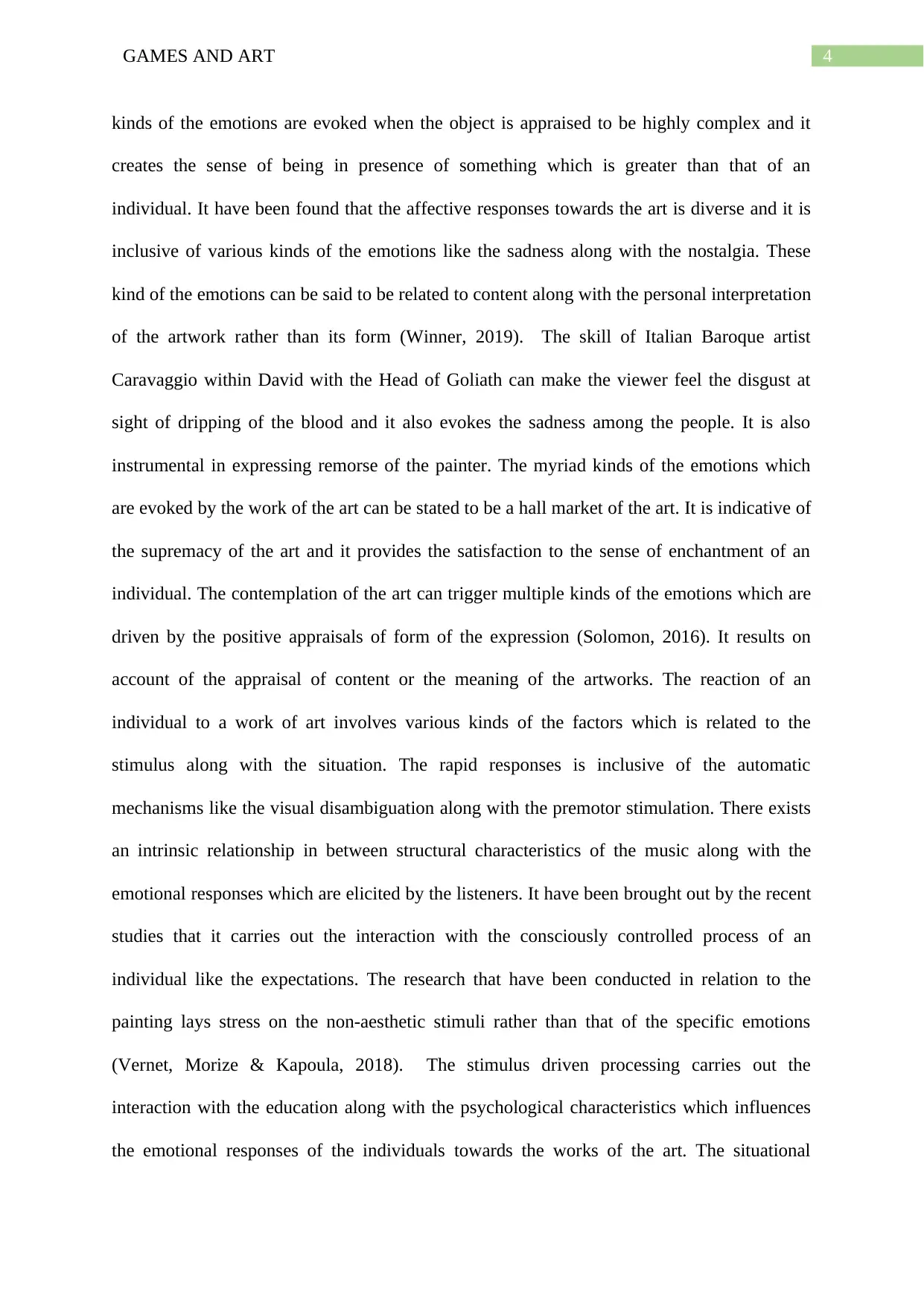
4GAMES AND ART
kinds of the emotions are evoked when the object is appraised to be highly complex and it
creates the sense of being in presence of something which is greater than that of an
individual. It have been found that the affective responses towards the art is diverse and it is
inclusive of various kinds of the emotions like the sadness along with the nostalgia. These
kind of the emotions can be said to be related to content along with the personal interpretation
of the artwork rather than its form (Winner, 2019). The skill of Italian Baroque artist
Caravaggio within David with the Head of Goliath can make the viewer feel the disgust at
sight of dripping of the blood and it also evokes the sadness among the people. It is also
instrumental in expressing remorse of the painter. The myriad kinds of the emotions which
are evoked by the work of the art can be stated to be a hall market of the art. It is indicative of
the supremacy of the art and it provides the satisfaction to the sense of enchantment of an
individual. The contemplation of the art can trigger multiple kinds of the emotions which are
driven by the positive appraisals of form of the expression (Solomon, 2016). It results on
account of the appraisal of content or the meaning of the artworks. The reaction of an
individual to a work of art involves various kinds of the factors which is related to the
stimulus along with the situation. The rapid responses is inclusive of the automatic
mechanisms like the visual disambiguation along with the premotor stimulation. There exists
an intrinsic relationship in between structural characteristics of the music along with the
emotional responses which are elicited by the listeners. It have been brought out by the recent
studies that it carries out the interaction with the consciously controlled process of an
individual like the expectations. The research that have been conducted in relation to the
painting lays stress on the non-aesthetic stimuli rather than that of the specific emotions
(Vernet, Morize & Kapoula, 2018). The stimulus driven processing carries out the
interaction with the education along with the psychological characteristics which influences
the emotional responses of the individuals towards the works of the art. The situational
kinds of the emotions are evoked when the object is appraised to be highly complex and it
creates the sense of being in presence of something which is greater than that of an
individual. It have been found that the affective responses towards the art is diverse and it is
inclusive of various kinds of the emotions like the sadness along with the nostalgia. These
kind of the emotions can be said to be related to content along with the personal interpretation
of the artwork rather than its form (Winner, 2019). The skill of Italian Baroque artist
Caravaggio within David with the Head of Goliath can make the viewer feel the disgust at
sight of dripping of the blood and it also evokes the sadness among the people. It is also
instrumental in expressing remorse of the painter. The myriad kinds of the emotions which
are evoked by the work of the art can be stated to be a hall market of the art. It is indicative of
the supremacy of the art and it provides the satisfaction to the sense of enchantment of an
individual. The contemplation of the art can trigger multiple kinds of the emotions which are
driven by the positive appraisals of form of the expression (Solomon, 2016). It results on
account of the appraisal of content or the meaning of the artworks. The reaction of an
individual to a work of art involves various kinds of the factors which is related to the
stimulus along with the situation. The rapid responses is inclusive of the automatic
mechanisms like the visual disambiguation along with the premotor stimulation. There exists
an intrinsic relationship in between structural characteristics of the music along with the
emotional responses which are elicited by the listeners. It have been brought out by the recent
studies that it carries out the interaction with the consciously controlled process of an
individual like the expectations. The research that have been conducted in relation to the
painting lays stress on the non-aesthetic stimuli rather than that of the specific emotions
(Vernet, Morize & Kapoula, 2018). The stimulus driven processing carries out the
interaction with the education along with the psychological characteristics which influences
the emotional responses of the individuals towards the works of the art. The situational
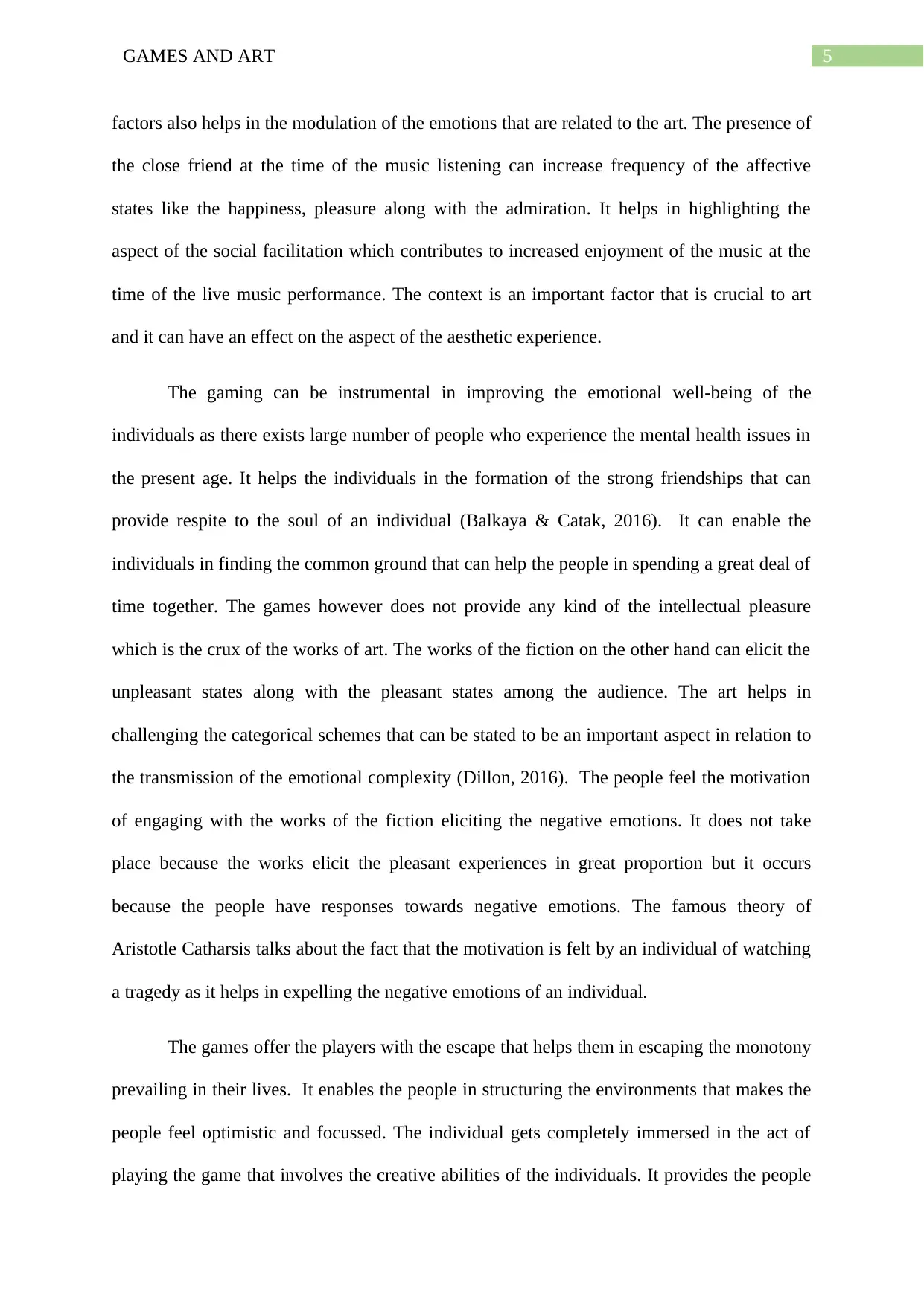
5GAMES AND ART
factors also helps in the modulation of the emotions that are related to the art. The presence of
the close friend at the time of the music listening can increase frequency of the affective
states like the happiness, pleasure along with the admiration. It helps in highlighting the
aspect of the social facilitation which contributes to increased enjoyment of the music at the
time of the live music performance. The context is an important factor that is crucial to art
and it can have an effect on the aspect of the aesthetic experience.
The gaming can be instrumental in improving the emotional well-being of the
individuals as there exists large number of people who experience the mental health issues in
the present age. It helps the individuals in the formation of the strong friendships that can
provide respite to the soul of an individual (Balkaya & Catak, 2016). It can enable the
individuals in finding the common ground that can help the people in spending a great deal of
time together. The games however does not provide any kind of the intellectual pleasure
which is the crux of the works of art. The works of the fiction on the other hand can elicit the
unpleasant states along with the pleasant states among the audience. The art helps in
challenging the categorical schemes that can be stated to be an important aspect in relation to
the transmission of the emotional complexity (Dillon, 2016). The people feel the motivation
of engaging with the works of the fiction eliciting the negative emotions. It does not take
place because the works elicit the pleasant experiences in great proportion but it occurs
because the people have responses towards negative emotions. The famous theory of
Aristotle Catharsis talks about the fact that the motivation is felt by an individual of watching
a tragedy as it helps in expelling the negative emotions of an individual.
The games offer the players with the escape that helps them in escaping the monotony
prevailing in their lives. It enables the people in structuring the environments that makes the
people feel optimistic and focussed. The individual gets completely immersed in the act of
playing the game that involves the creative abilities of the individuals. It provides the people
factors also helps in the modulation of the emotions that are related to the art. The presence of
the close friend at the time of the music listening can increase frequency of the affective
states like the happiness, pleasure along with the admiration. It helps in highlighting the
aspect of the social facilitation which contributes to increased enjoyment of the music at the
time of the live music performance. The context is an important factor that is crucial to art
and it can have an effect on the aspect of the aesthetic experience.
The gaming can be instrumental in improving the emotional well-being of the
individuals as there exists large number of people who experience the mental health issues in
the present age. It helps the individuals in the formation of the strong friendships that can
provide respite to the soul of an individual (Balkaya & Catak, 2016). It can enable the
individuals in finding the common ground that can help the people in spending a great deal of
time together. The games however does not provide any kind of the intellectual pleasure
which is the crux of the works of art. The works of the fiction on the other hand can elicit the
unpleasant states along with the pleasant states among the audience. The art helps in
challenging the categorical schemes that can be stated to be an important aspect in relation to
the transmission of the emotional complexity (Dillon, 2016). The people feel the motivation
of engaging with the works of the fiction eliciting the negative emotions. It does not take
place because the works elicit the pleasant experiences in great proportion but it occurs
because the people have responses towards negative emotions. The famous theory of
Aristotle Catharsis talks about the fact that the motivation is felt by an individual of watching
a tragedy as it helps in expelling the negative emotions of an individual.
The games offer the players with the escape that helps them in escaping the monotony
prevailing in their lives. It enables the people in structuring the environments that makes the
people feel optimistic and focussed. The individual gets completely immersed in the act of
playing the game that involves the creative abilities of the individuals. It provides the people
⊘ This is a preview!⊘
Do you want full access?
Subscribe today to unlock all pages.

Trusted by 1+ million students worldwide
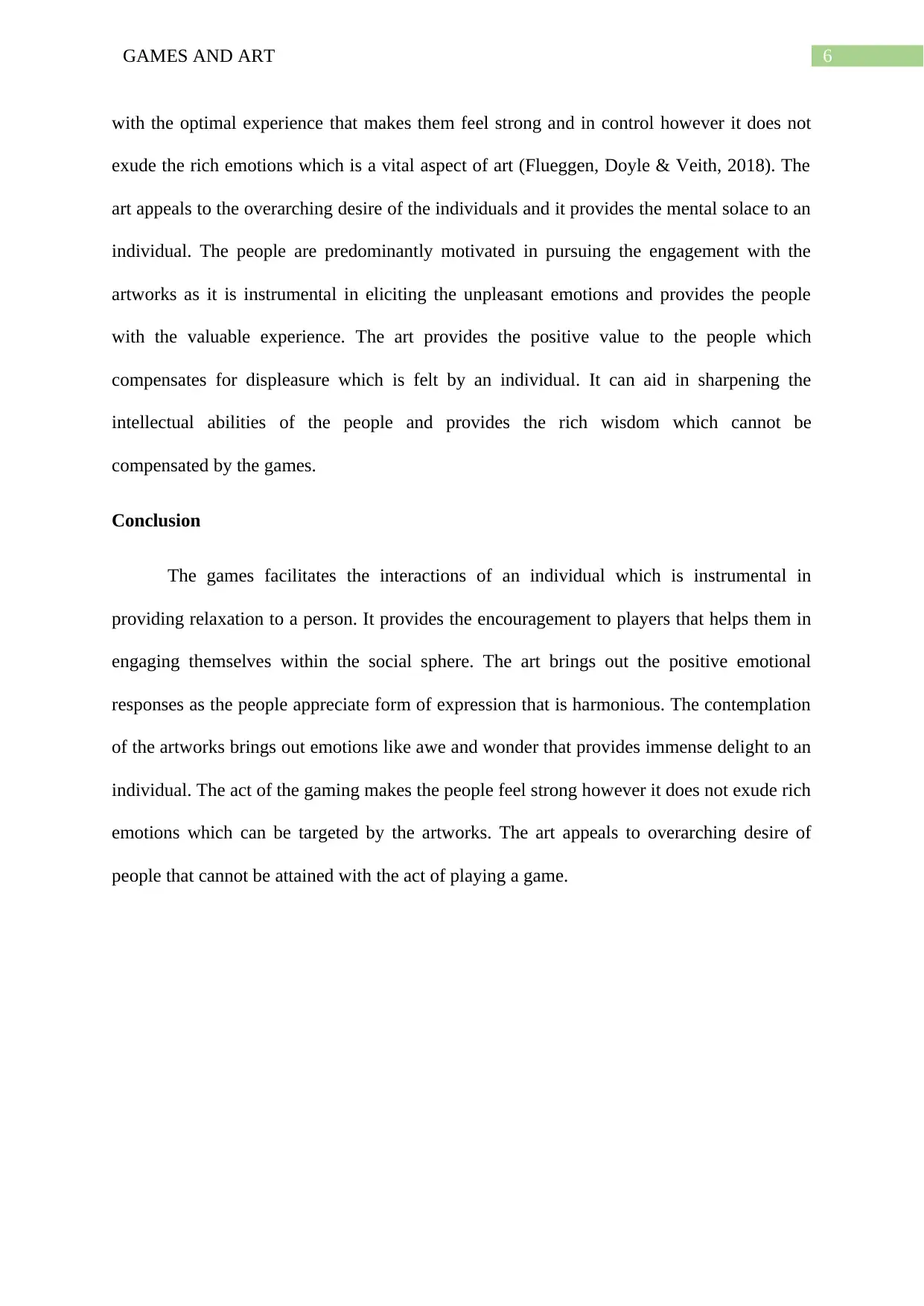
6GAMES AND ART
with the optimal experience that makes them feel strong and in control however it does not
exude the rich emotions which is a vital aspect of art (Flueggen, Doyle & Veith, 2018). The
art appeals to the overarching desire of the individuals and it provides the mental solace to an
individual. The people are predominantly motivated in pursuing the engagement with the
artworks as it is instrumental in eliciting the unpleasant emotions and provides the people
with the valuable experience. The art provides the positive value to the people which
compensates for displeasure which is felt by an individual. It can aid in sharpening the
intellectual abilities of the people and provides the rich wisdom which cannot be
compensated by the games.
Conclusion
The games facilitates the interactions of an individual which is instrumental in
providing relaxation to a person. It provides the encouragement to players that helps them in
engaging themselves within the social sphere. The art brings out the positive emotional
responses as the people appreciate form of expression that is harmonious. The contemplation
of the artworks brings out emotions like awe and wonder that provides immense delight to an
individual. The act of the gaming makes the people feel strong however it does not exude rich
emotions which can be targeted by the artworks. The art appeals to overarching desire of
people that cannot be attained with the act of playing a game.
with the optimal experience that makes them feel strong and in control however it does not
exude the rich emotions which is a vital aspect of art (Flueggen, Doyle & Veith, 2018). The
art appeals to the overarching desire of the individuals and it provides the mental solace to an
individual. The people are predominantly motivated in pursuing the engagement with the
artworks as it is instrumental in eliciting the unpleasant emotions and provides the people
with the valuable experience. The art provides the positive value to the people which
compensates for displeasure which is felt by an individual. It can aid in sharpening the
intellectual abilities of the people and provides the rich wisdom which cannot be
compensated by the games.
Conclusion
The games facilitates the interactions of an individual which is instrumental in
providing relaxation to a person. It provides the encouragement to players that helps them in
engaging themselves within the social sphere. The art brings out the positive emotional
responses as the people appreciate form of expression that is harmonious. The contemplation
of the artworks brings out emotions like awe and wonder that provides immense delight to an
individual. The act of the gaming makes the people feel strong however it does not exude rich
emotions which can be targeted by the artworks. The art appeals to overarching desire of
people that cannot be attained with the act of playing a game.
Paraphrase This Document
Need a fresh take? Get an instant paraphrase of this document with our AI Paraphraser
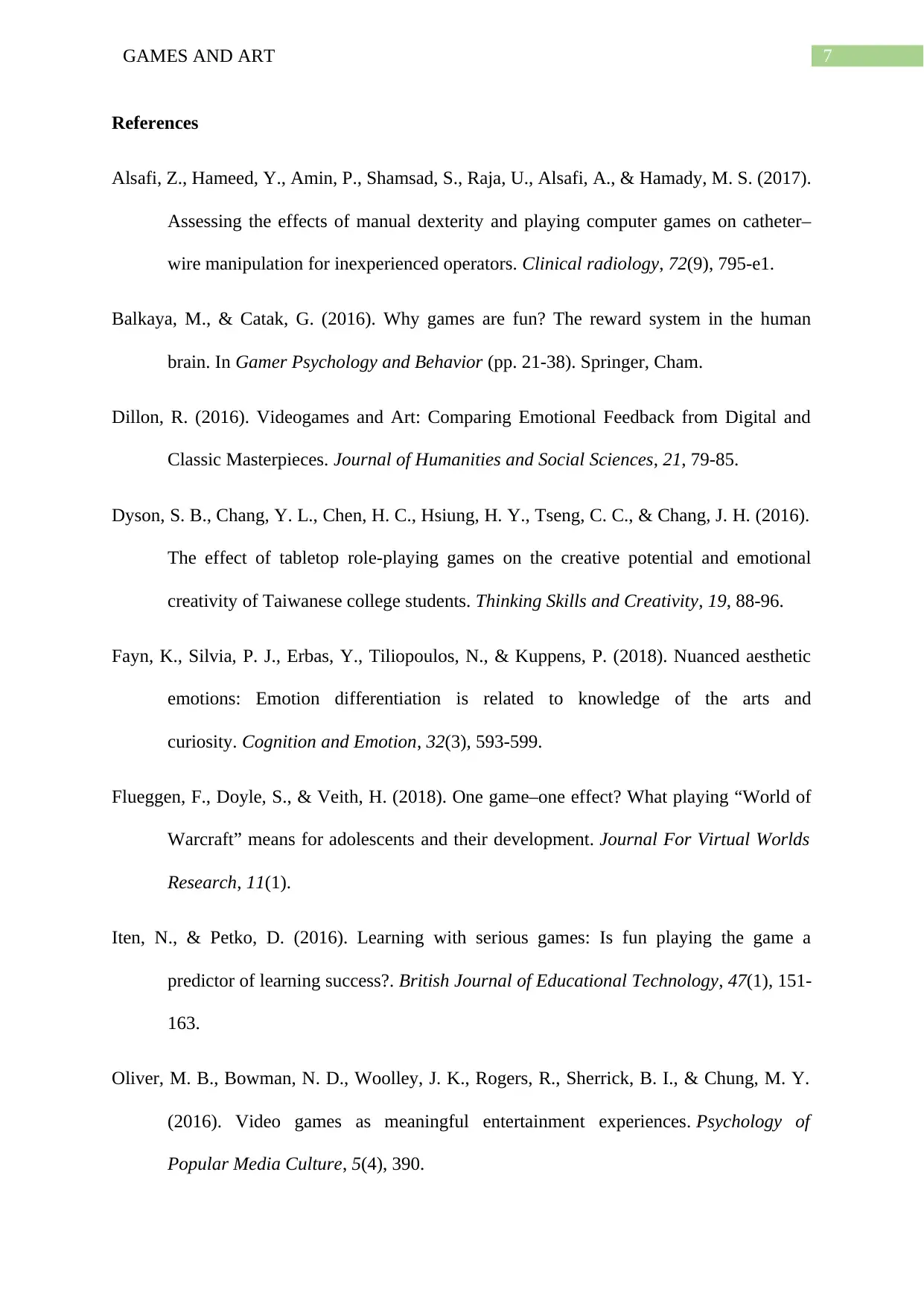
7GAMES AND ART
References
Alsafi, Z., Hameed, Y., Amin, P., Shamsad, S., Raja, U., Alsafi, A., & Hamady, M. S. (2017).
Assessing the effects of manual dexterity and playing computer games on catheter–
wire manipulation for inexperienced operators. Clinical radiology, 72(9), 795-e1.
Balkaya, M., & Catak, G. (2016). Why games are fun? The reward system in the human
brain. In Gamer Psychology and Behavior (pp. 21-38). Springer, Cham.
Dillon, R. (2016). Videogames and Art: Comparing Emotional Feedback from Digital and
Classic Masterpieces. Journal of Humanities and Social Sciences, 21, 79-85.
Dyson, S. B., Chang, Y. L., Chen, H. C., Hsiung, H. Y., Tseng, C. C., & Chang, J. H. (2016).
The effect of tabletop role-playing games on the creative potential and emotional
creativity of Taiwanese college students. Thinking Skills and Creativity, 19, 88-96.
Fayn, K., Silvia, P. J., Erbas, Y., Tiliopoulos, N., & Kuppens, P. (2018). Nuanced aesthetic
emotions: Emotion differentiation is related to knowledge of the arts and
curiosity. Cognition and Emotion, 32(3), 593-599.
Flueggen, F., Doyle, S., & Veith, H. (2018). One game–one effect? What playing “World of
Warcraft” means for adolescents and their development. Journal For Virtual Worlds
Research, 11(1).
Iten, N., & Petko, D. (2016). Learning with serious games: Is fun playing the game a
predictor of learning success?. British Journal of Educational Technology, 47(1), 151-
163.
Oliver, M. B., Bowman, N. D., Woolley, J. K., Rogers, R., Sherrick, B. I., & Chung, M. Y.
(2016). Video games as meaningful entertainment experiences. Psychology of
Popular Media Culture, 5(4), 390.
References
Alsafi, Z., Hameed, Y., Amin, P., Shamsad, S., Raja, U., Alsafi, A., & Hamady, M. S. (2017).
Assessing the effects of manual dexterity and playing computer games on catheter–
wire manipulation for inexperienced operators. Clinical radiology, 72(9), 795-e1.
Balkaya, M., & Catak, G. (2016). Why games are fun? The reward system in the human
brain. In Gamer Psychology and Behavior (pp. 21-38). Springer, Cham.
Dillon, R. (2016). Videogames and Art: Comparing Emotional Feedback from Digital and
Classic Masterpieces. Journal of Humanities and Social Sciences, 21, 79-85.
Dyson, S. B., Chang, Y. L., Chen, H. C., Hsiung, H. Y., Tseng, C. C., & Chang, J. H. (2016).
The effect of tabletop role-playing games on the creative potential and emotional
creativity of Taiwanese college students. Thinking Skills and Creativity, 19, 88-96.
Fayn, K., Silvia, P. J., Erbas, Y., Tiliopoulos, N., & Kuppens, P. (2018). Nuanced aesthetic
emotions: Emotion differentiation is related to knowledge of the arts and
curiosity. Cognition and Emotion, 32(3), 593-599.
Flueggen, F., Doyle, S., & Veith, H. (2018). One game–one effect? What playing “World of
Warcraft” means for adolescents and their development. Journal For Virtual Worlds
Research, 11(1).
Iten, N., & Petko, D. (2016). Learning with serious games: Is fun playing the game a
predictor of learning success?. British Journal of Educational Technology, 47(1), 151-
163.
Oliver, M. B., Bowman, N. D., Woolley, J. K., Rogers, R., Sherrick, B. I., & Chung, M. Y.
(2016). Video games as meaningful entertainment experiences. Psychology of
Popular Media Culture, 5(4), 390.
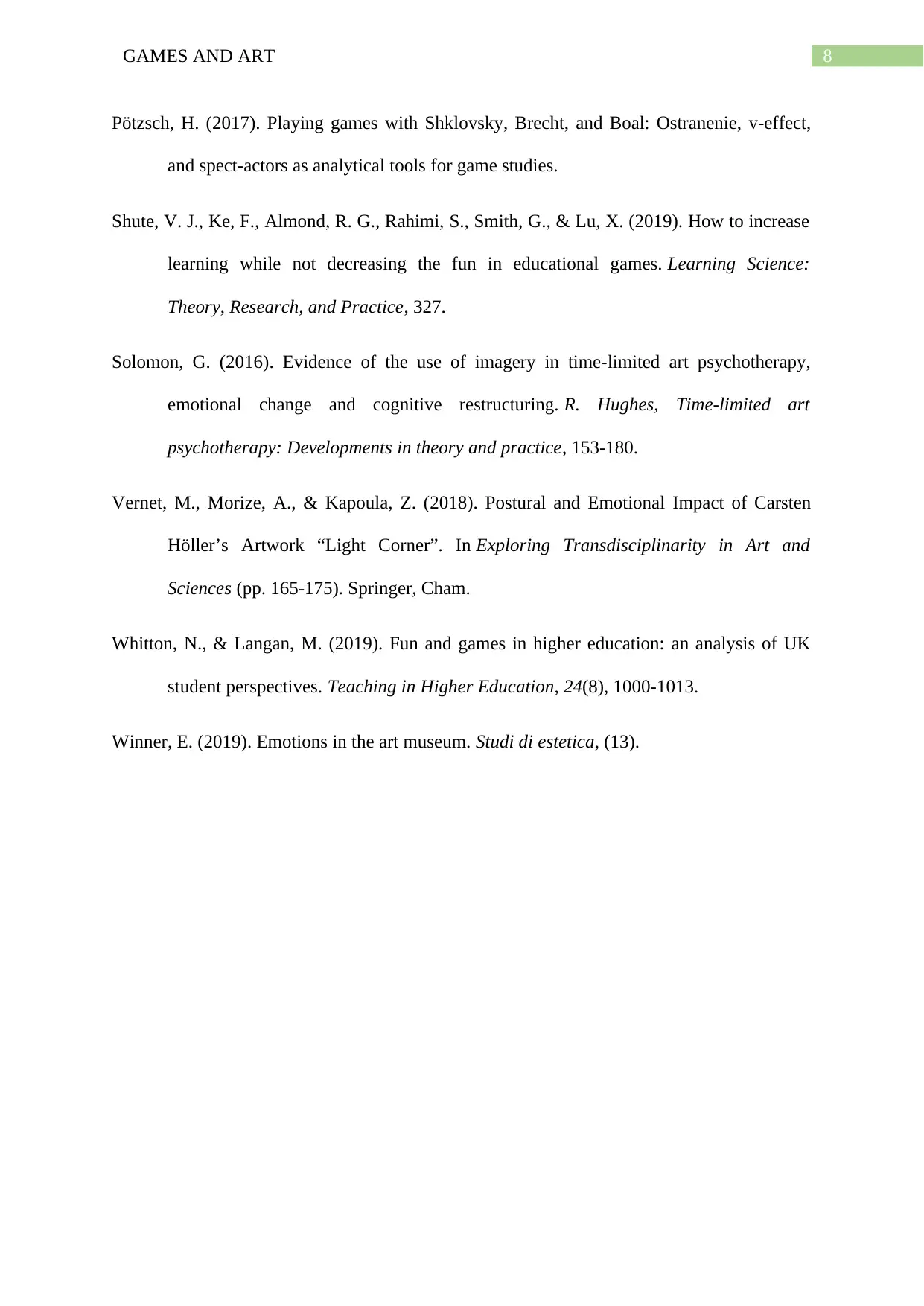
8GAMES AND ART
Pötzsch, H. (2017). Playing games with Shklovsky, Brecht, and Boal: Ostranenie, v-effect,
and spect-actors as analytical tools for game studies.
Shute, V. J., Ke, F., Almond, R. G., Rahimi, S., Smith, G., & Lu, X. (2019). How to increase
learning while not decreasing the fun in educational games. Learning Science:
Theory, Research, and Practice, 327.
Solomon, G. (2016). Evidence of the use of imagery in time-limited art psychotherapy,
emotional change and cognitive restructuring. R. Hughes, Time-limited art
psychotherapy: Developments in theory and practice, 153-180.
Vernet, M., Morize, A., & Kapoula, Z. (2018). Postural and Emotional Impact of Carsten
Höller’s Artwork “Light Corner”. In Exploring Transdisciplinarity in Art and
Sciences (pp. 165-175). Springer, Cham.
Whitton, N., & Langan, M. (2019). Fun and games in higher education: an analysis of UK
student perspectives. Teaching in Higher Education, 24(8), 1000-1013.
Winner, E. (2019). Emotions in the art museum. Studi di estetica, (13).
Pötzsch, H. (2017). Playing games with Shklovsky, Brecht, and Boal: Ostranenie, v-effect,
and spect-actors as analytical tools for game studies.
Shute, V. J., Ke, F., Almond, R. G., Rahimi, S., Smith, G., & Lu, X. (2019). How to increase
learning while not decreasing the fun in educational games. Learning Science:
Theory, Research, and Practice, 327.
Solomon, G. (2016). Evidence of the use of imagery in time-limited art psychotherapy,
emotional change and cognitive restructuring. R. Hughes, Time-limited art
psychotherapy: Developments in theory and practice, 153-180.
Vernet, M., Morize, A., & Kapoula, Z. (2018). Postural and Emotional Impact of Carsten
Höller’s Artwork “Light Corner”. In Exploring Transdisciplinarity in Art and
Sciences (pp. 165-175). Springer, Cham.
Whitton, N., & Langan, M. (2019). Fun and games in higher education: an analysis of UK
student perspectives. Teaching in Higher Education, 24(8), 1000-1013.
Winner, E. (2019). Emotions in the art museum. Studi di estetica, (13).
⊘ This is a preview!⊘
Do you want full access?
Subscribe today to unlock all pages.

Trusted by 1+ million students worldwide
1 out of 9
Related Documents
Your All-in-One AI-Powered Toolkit for Academic Success.
+13062052269
info@desklib.com
Available 24*7 on WhatsApp / Email
![[object Object]](/_next/static/media/star-bottom.7253800d.svg)
Unlock your academic potential
Copyright © 2020–2025 A2Z Services. All Rights Reserved. Developed and managed by ZUCOL.





